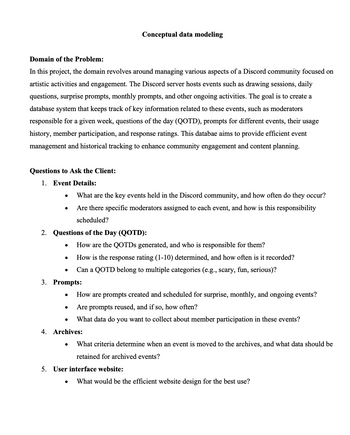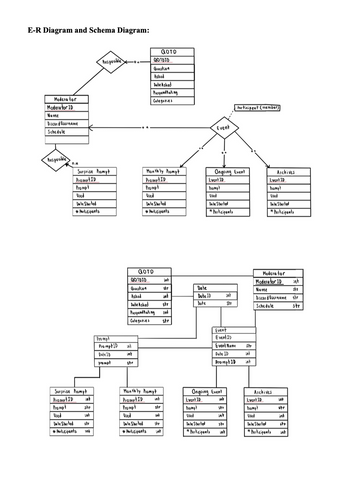
Concept explainers
I want to create logical
1. Normalize the relations to at least third normal form (3NF) using proper standard E-R diagram notation. Provide the appropriate relational schema reduction.
2. Identify the primary and foreign keys for each relation (using appropriate notation). Maybe either list the primary and foreign keys or generate a schema diagram???
3. Identify and describe any indexes needed to speed up searches on non-key attributes – can you explain it too? So I would understand why you come up with the answer please?
4. Identify and describe unique, conditional (check), non-null, referential integrity, or other constraints needed to guarantee the integrity of the database.
5. Describe the set of business or workflow rules applicable to your project. Next, describe at what point in the workflow you will implement the business or workflow logic and the justification for doing so.
Below are my conceptual design.


Trending nowThis is a popular solution!
Step by stepSolved in 6 steps

- There are two views of the data i.e., the logical view and the physical view. In relation to relational database, explain why different views are necessary in database applications. Why an understanding of logical data structures is necessary to assist you when designing and using database systems?arrow_forwardThe following exercises are based on the BITS database user views as designed in Your Turn 6-1 in this chapter. In each exercise, represent your answer in DBDL and with an Entity Relationship Diagram. 1. Indicate the changes you need to make to the design of the BITS database to support the following situation. A client is not necessarily represented by a single consultant but can be represented by several consultants.arrow_forwardConsider the unnormalized data presented in the STUDENT table below:a) Identify the data redundancies and give reasons why they create problems in schemas. STUNUM STUNAME TUTNUM TUTNAME COURSENUM COURSEDESC GRADE 00118536 John Brown RC985 Rose Carter CS1001 CS1002 CS1003 Comp Research English Database design B A A 00118537 Marie Smith TB526 Tom Black CS9001 CS9002 CS1002 Calculus Javascript English A B C 00118538 Mary Cole PF587 Peter Finch CS9002 CS1003 CS1001 Javascript Database design Comp Research C A A 00118539 Ian Dunkley SH231 Sarah Hardy CS9005 CS9006 CS1002 Information Systems Web Design English A B B 00118540 Bob Marley JH850 Jacqui Hart CS9002 CS1002 CS1003 JavaScript English Database Deign A B C b) Which dependencies represent 1NF violations? Identify and eliminate 1NF violations. Present your table(s) after transformation into 1NF.c) Identify and remove any 2NF violations. Show the resulting schemas and tablesd) Identify and…arrow_forward
- when would a database designer need to createin a artifical key? a)when no simple or composite primary key exist in a table b) When the primary key is identical to the supertype primary key. c) When there is no single columns key avialable d) When there is an ISA relationship in a tablearrow_forwardBased on BITS database user views as designed in Your Turn 6-1 in this chapter. In each exercise, represent your answer in DBDL and with an Entity Relationship Diagram. 2. Indicate the changes you need to make to the design of the BITS database to support the following situation. There is no relationship between clients and consultants. When a client places an order (service request), it may be performed by any consultant. On the order, identify both the client placing the order and the consultant responsible for the order.arrow_forwardAll of you must be familier with human resources system (employee database). Soplease design database for a human resources system that at least has 4 entitiesinvolved and for the 4 entities please do the following:a. Create the tables that conform to 3NF.b. Draw the Crow’s Foot ERD to reflect the dependency and relationshipdiagrams;c. For all entities/tables created please write the MASTER and TRANSACTIONdata accordingly!d. Use SQL commands to to do selection which involve 1 table, 2 tables, and 3tables.arrow_forward
- 7. In the context of database design, consider the following scenario: There is database table that contains columns for employee ID, employee name, department, department location, and project details. Upon analyzing the table, you notice that there are multiple rows with the same employee name, department, and department location, but different project details. Based on this scenario, which of the following best describes the normalization process that should be applied to improve the database design? A) Split the table into two: one containing employee ID and employee name, and the other containing department, department location, and project details. B) Combine all columns into a single table to reduce redundancy. C) Normalize the database to the third normal form by creating separate tables for employee details, department details, and project details, and establish relationships between them. D) No action is required as the table already follows the normalization principles.arrow_forwardHi, I could use help on making ERD's for this problem. It needs to be crows-foot notation. It must have entities, attributes, relationships, cardinalities, primary keys, and foreign keys. Please break this down so I can make sure I understand. Here is the description: Marsha Mobley, the manager of the ACME Anime Shop wants you to design a database system that will enable a number of tasks. One problem that Marsha has is keeping track of inventory. Several times a week the store receives shipments from various vendors. Marsha would like a system that can record these shipments. Most of the shipment information originates with an order to the vendor.Marsha currently records order information on an order form, which is shown below, along with the form currently used to record inventory. When shipments arrive, Marsha wants the system to indicate that the order has been received. More importantly, Marshaneeds the system to update the store inventory. The system should also record basic…arrow_forwardConvert each one of the diagram into a skeleton relational database schema. Express every relation in the form: R (A, B, C, D, E); Underline a primary key for each relation. Write the attributes of a composite key adjacent to each other – just like A, B in R (A, B, C, D Earrow_forward
- create a table for the class entity in an ER diagram of a school system. Show the composite key in class table. Fill the table with 4 records. At what level in the database architecture we create tables ?arrow_forwardConvert the following ER diagram into a relational database schema, be certain to indicate primary keys and referential integrity constraints.arrow_forwardIn the definition of a relational database, explain what is meant by "normalized relations" ?arrow_forward
 Database System ConceptsComputer ScienceISBN:9780078022159Author:Abraham Silberschatz Professor, Henry F. Korth, S. SudarshanPublisher:McGraw-Hill Education
Database System ConceptsComputer ScienceISBN:9780078022159Author:Abraham Silberschatz Professor, Henry F. Korth, S. SudarshanPublisher:McGraw-Hill Education Starting Out with Python (4th Edition)Computer ScienceISBN:9780134444321Author:Tony GaddisPublisher:PEARSON
Starting Out with Python (4th Edition)Computer ScienceISBN:9780134444321Author:Tony GaddisPublisher:PEARSON Digital Fundamentals (11th Edition)Computer ScienceISBN:9780132737968Author:Thomas L. FloydPublisher:PEARSON
Digital Fundamentals (11th Edition)Computer ScienceISBN:9780132737968Author:Thomas L. FloydPublisher:PEARSON C How to Program (8th Edition)Computer ScienceISBN:9780133976892Author:Paul J. Deitel, Harvey DeitelPublisher:PEARSON
C How to Program (8th Edition)Computer ScienceISBN:9780133976892Author:Paul J. Deitel, Harvey DeitelPublisher:PEARSON Database Systems: Design, Implementation, & Manag...Computer ScienceISBN:9781337627900Author:Carlos Coronel, Steven MorrisPublisher:Cengage Learning
Database Systems: Design, Implementation, & Manag...Computer ScienceISBN:9781337627900Author:Carlos Coronel, Steven MorrisPublisher:Cengage Learning Programmable Logic ControllersComputer ScienceISBN:9780073373843Author:Frank D. PetruzellaPublisher:McGraw-Hill Education
Programmable Logic ControllersComputer ScienceISBN:9780073373843Author:Frank D. PetruzellaPublisher:McGraw-Hill Education





